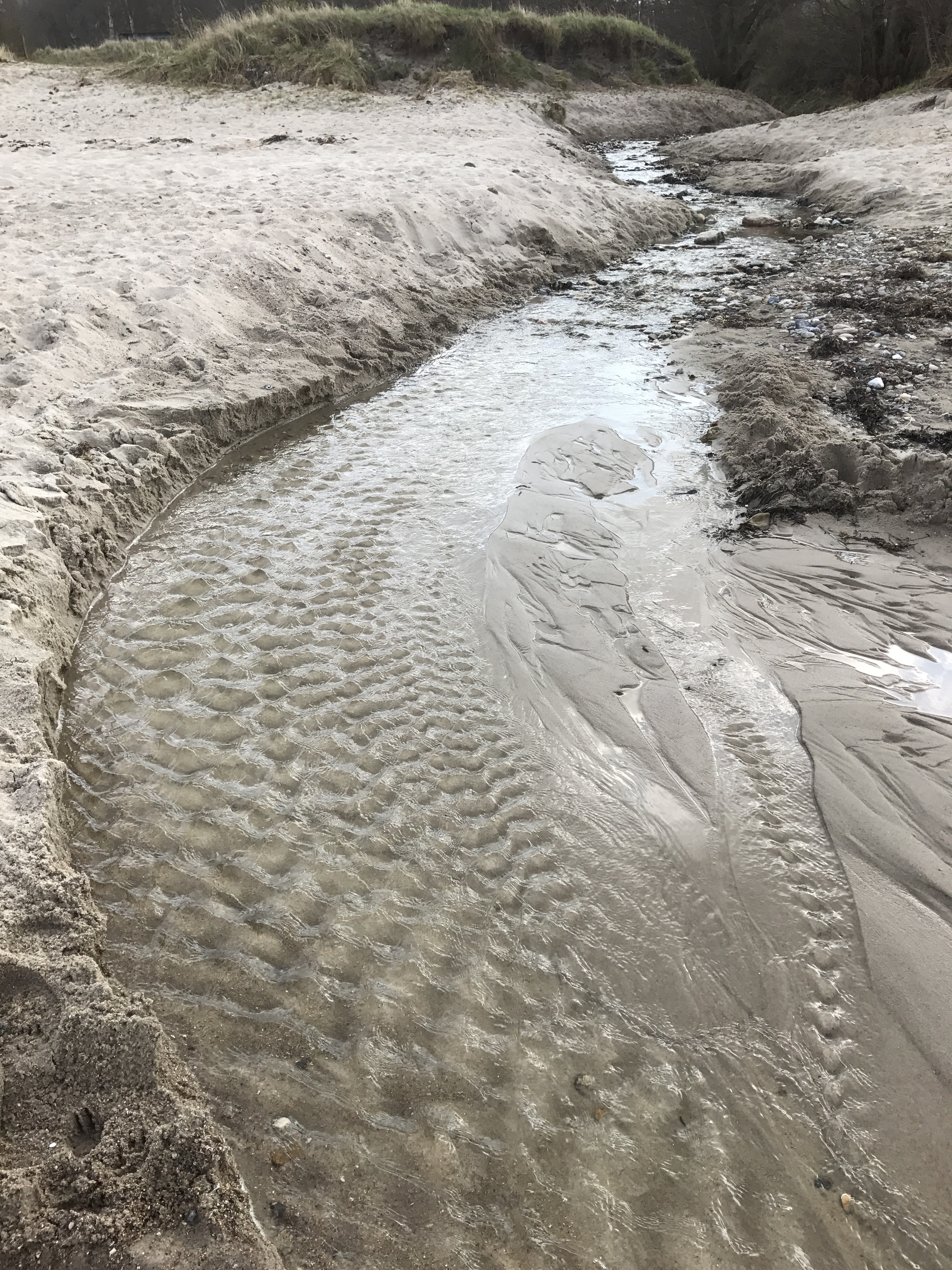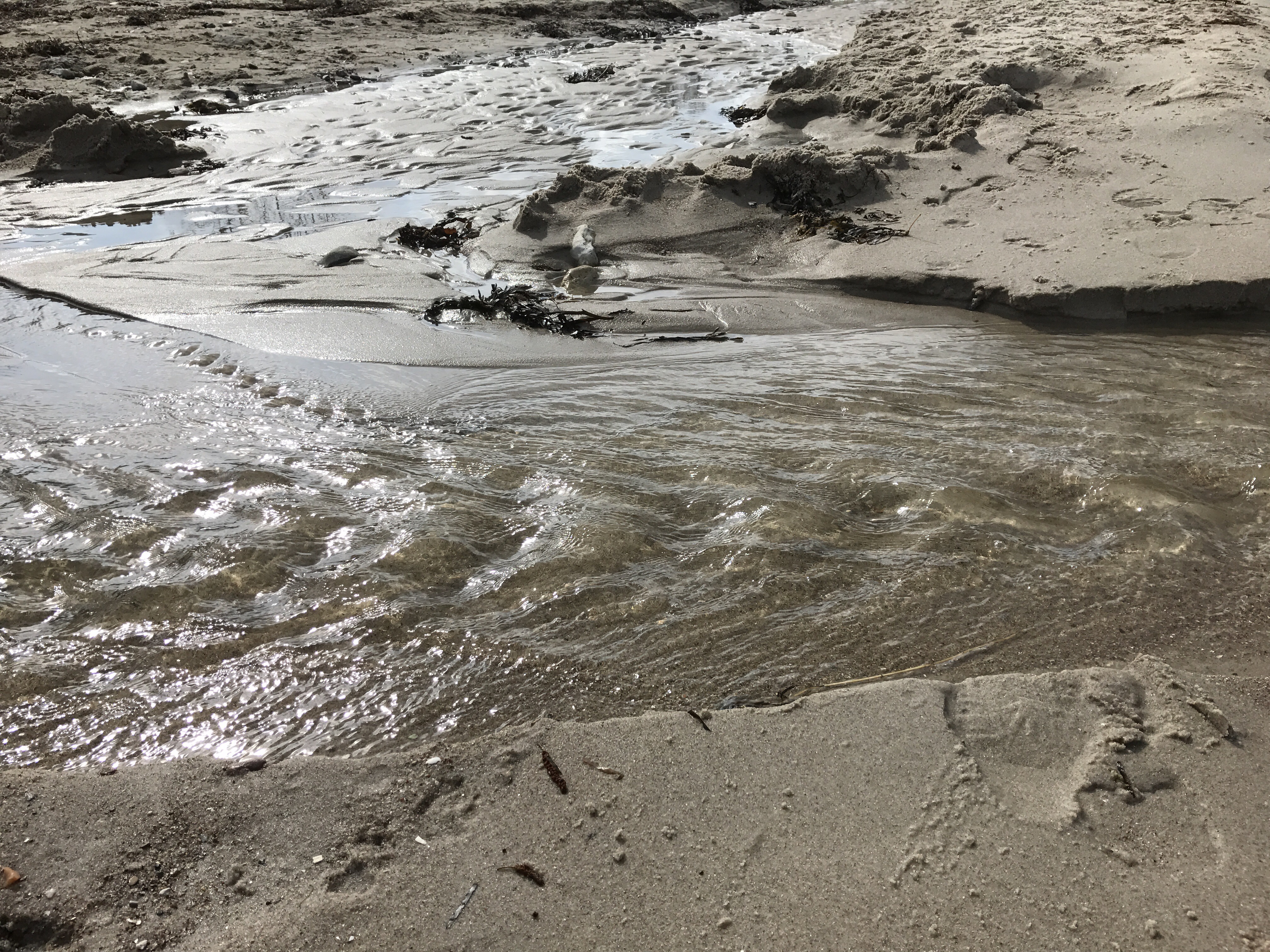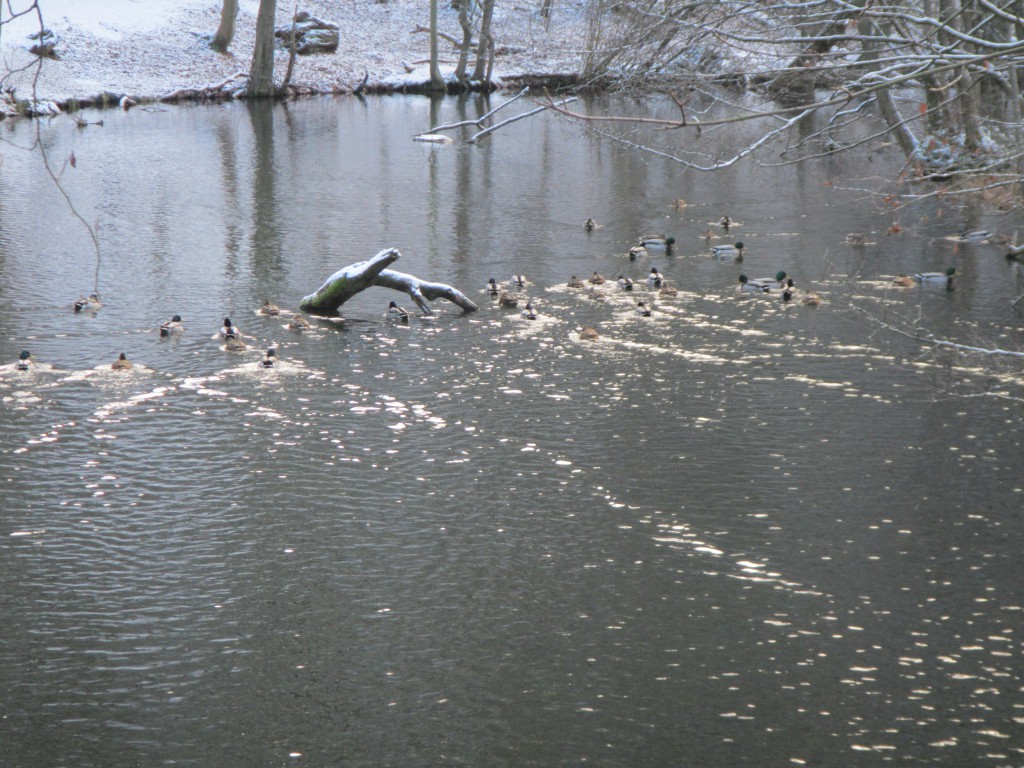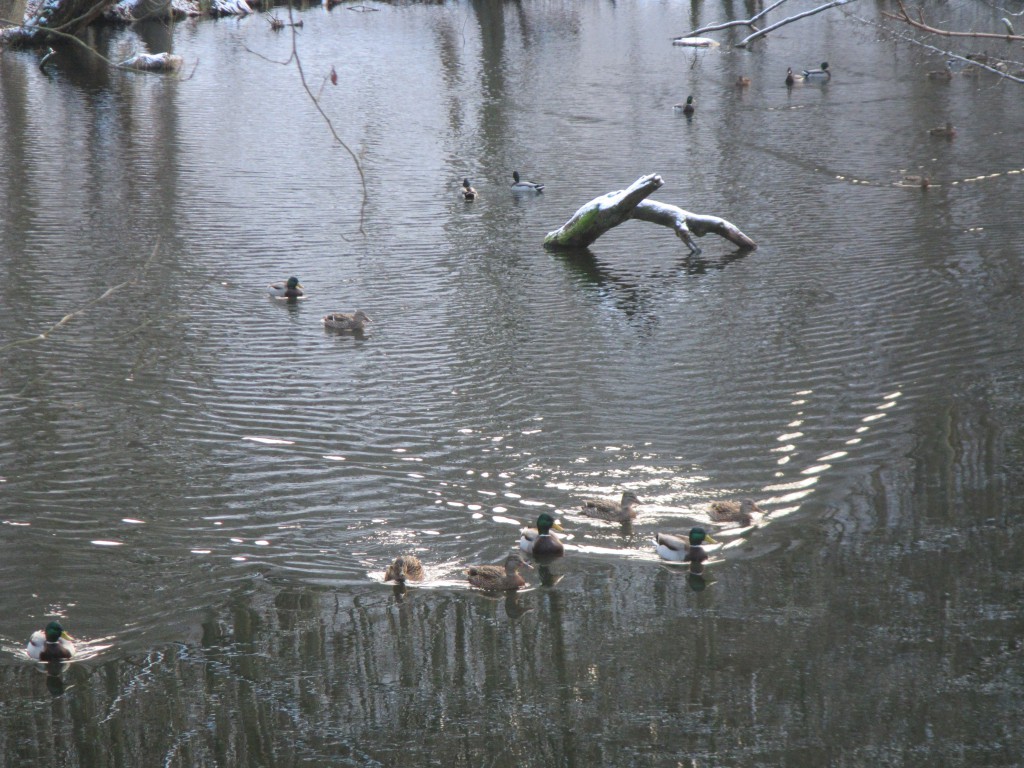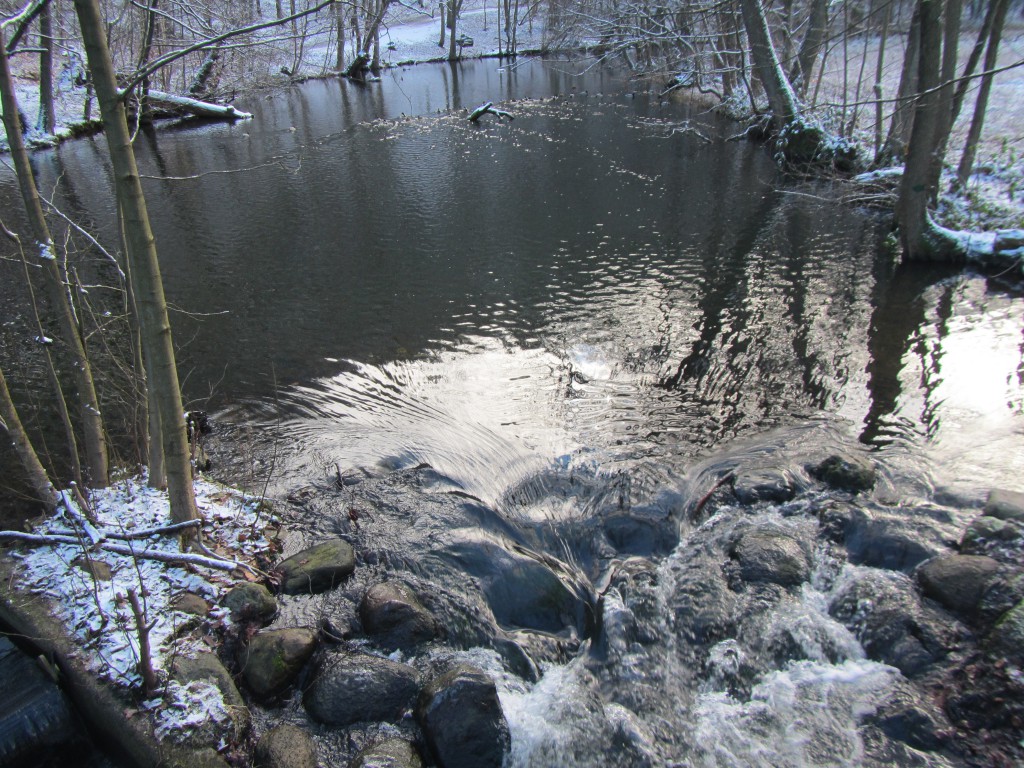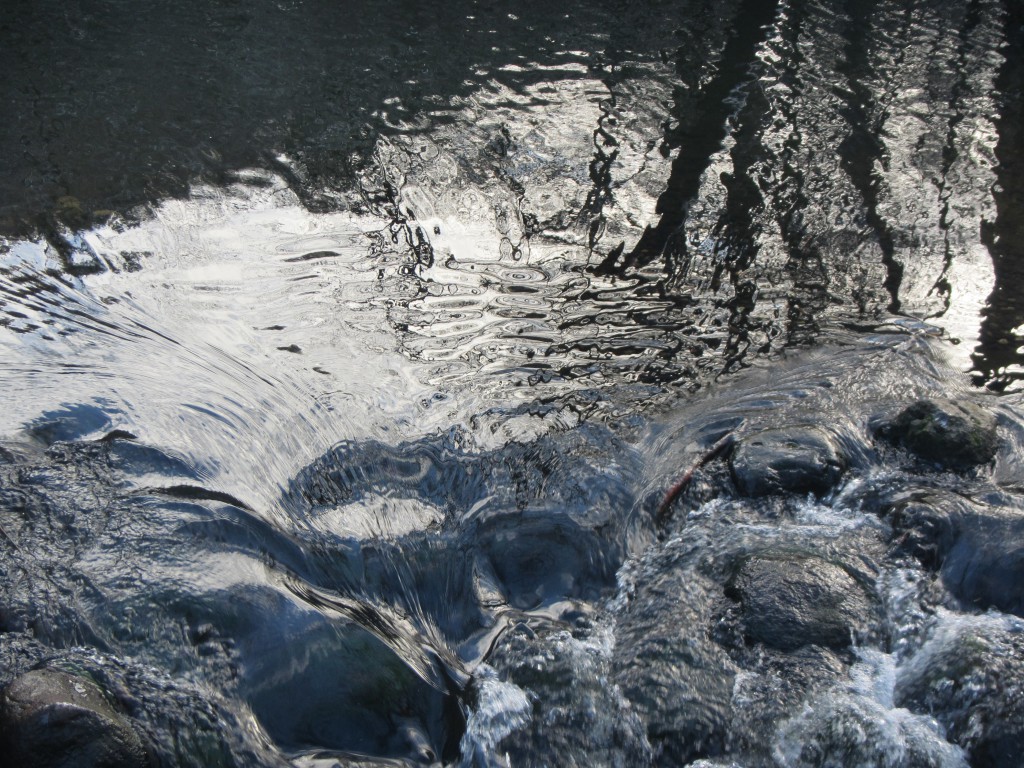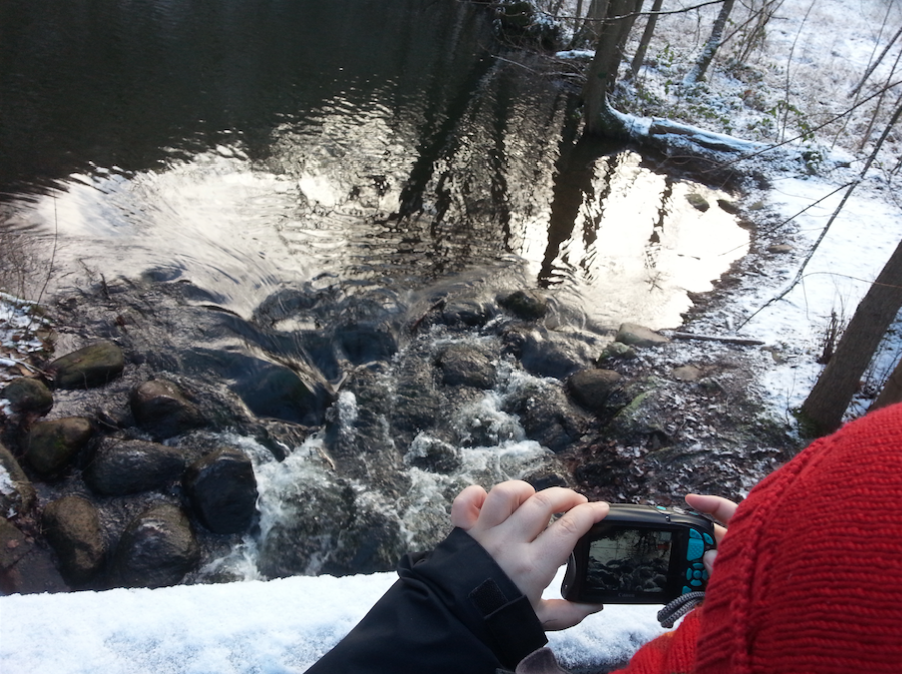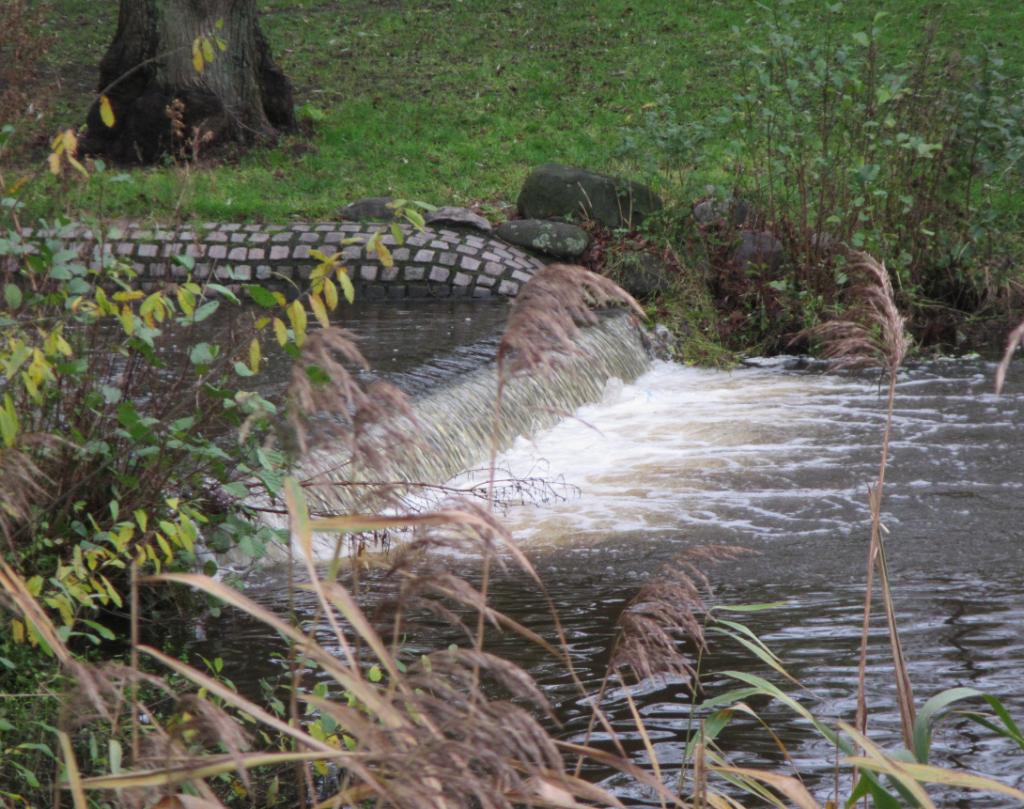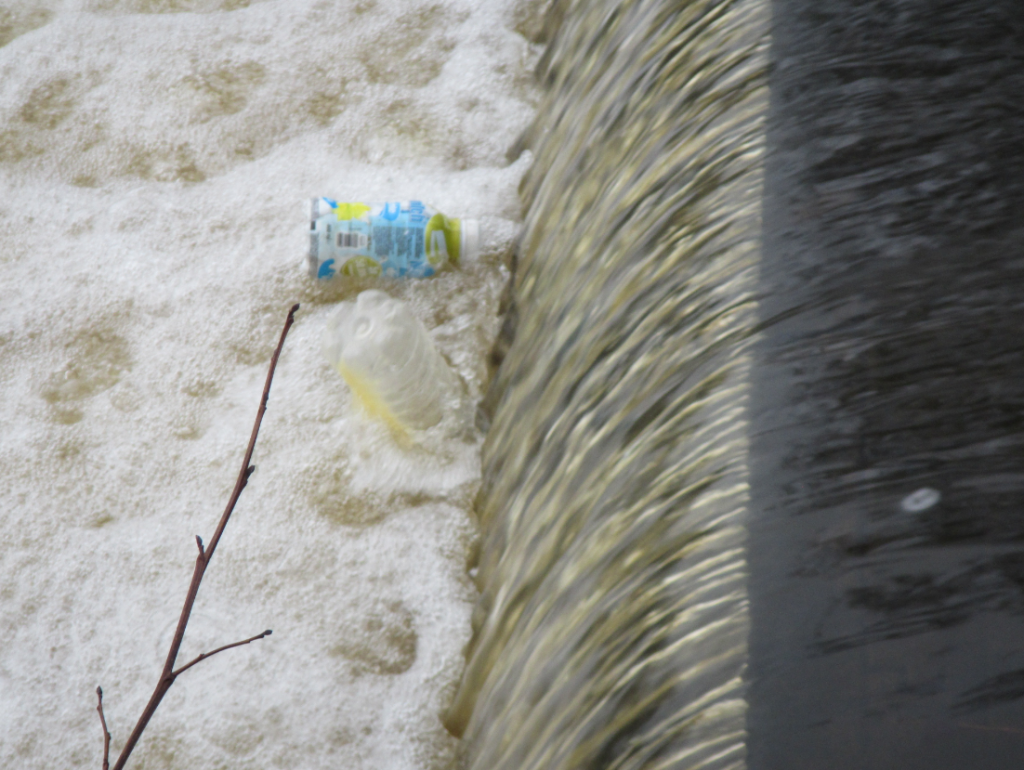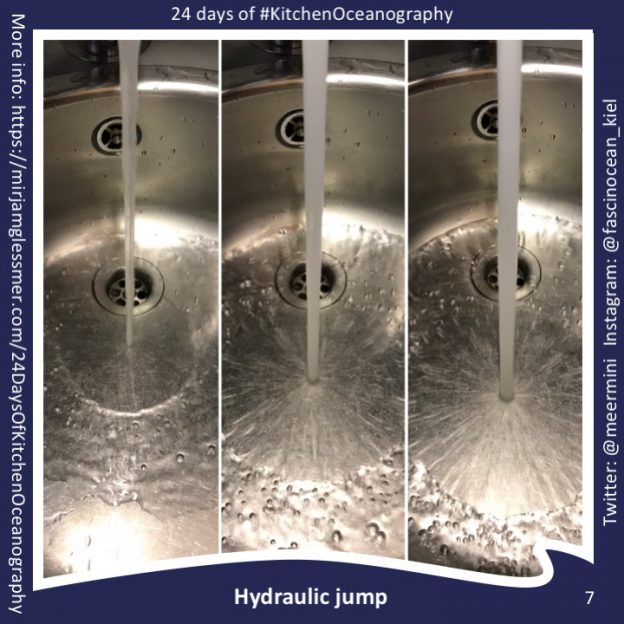
Tag Archives: hydraulic jump

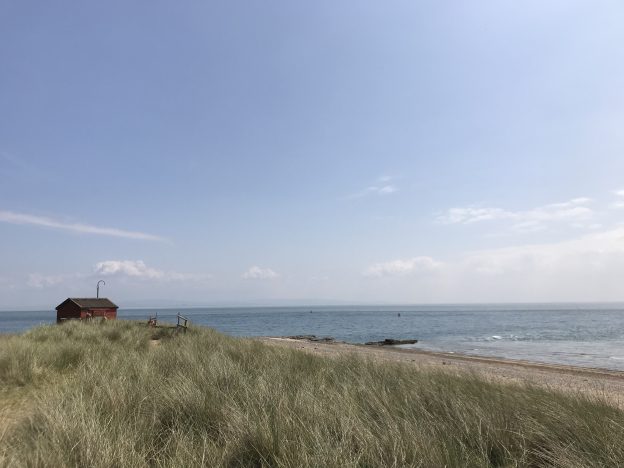
Watching the tides cause an hydraulic jump in the Irish Sea!
Looking at the picture above, taken in the South Walney Island Nature Reserve on our walk yesterday, what is the first thing you notice?
For me, it is not the cute little hide which is a perfect spot for seal and bird watching, for me it is — obviously! — what is going on with the waves! So much so that I spent the better part of an hour looking at the opposite direction of where all the seals were frolicking in the waves (except for one that came and played in the most fun part of the sea — more about that later).
Looking at the picture below, do you notice how different the different areas of water surface look? To the left of the wave breaker and going offshore from there, the surface is quite rough, with many waves of different wavelengths. But then going directly offshore from the wave breaker, the surface is smooth(er)! Followed by a rougher stripe, before it becomes smooth again, and a couple of well-defined wave crests reach the shore.
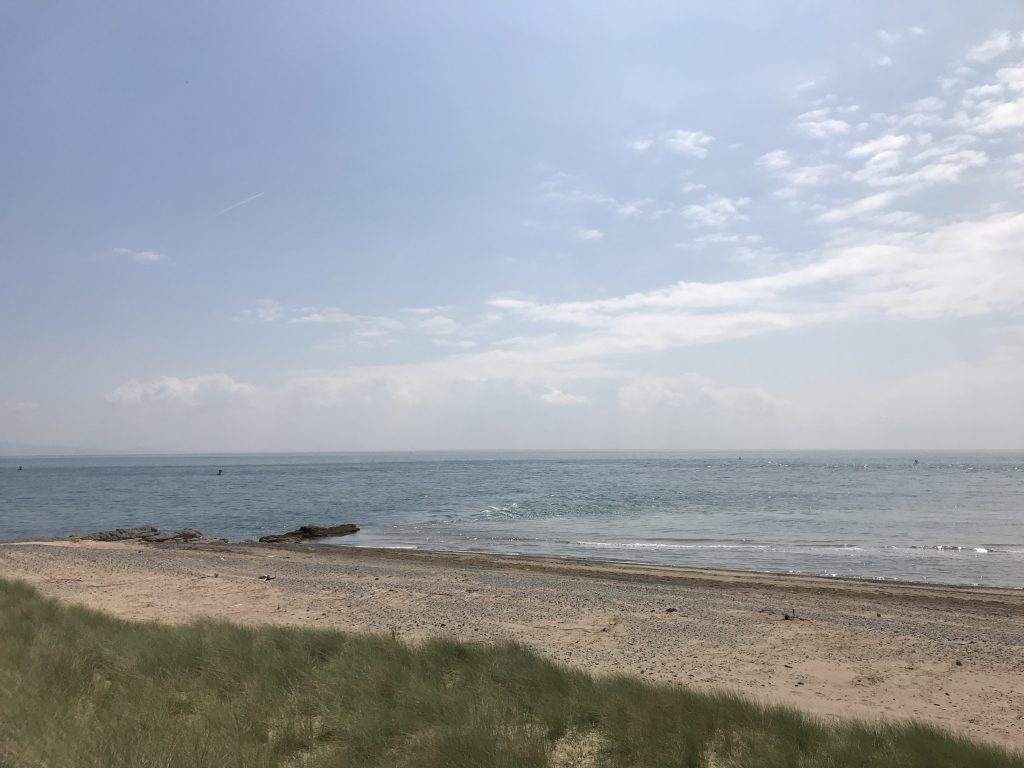
Zooming in on that area right off the wave breaker, you see that there are actually waves breaking towards the smoother area, away from the beach. Any idea what’s going on here, what might be causing those waves? (Hint: Even though there is a boat in the background, it is not some ship’s wake!)
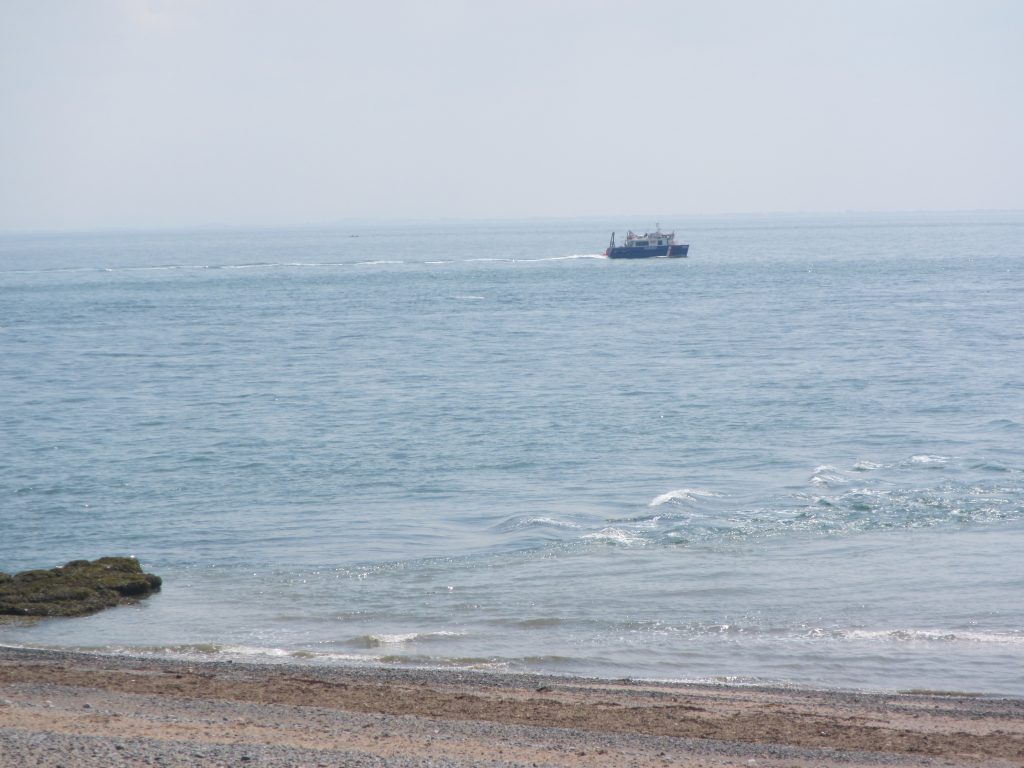
What we can observe here is actually a pretty cool phenomenon, called a hydraulic jump. Due to the tide going out, there is a current developing around the tip of Walney Island, going from left to right in the picture above. This current goes over the still-submerged part of the wave breaker. Since the cross section through which the water has to squeeze is all of a sudden a lot smaller than before and after, the water has to accelerate. And it accelerates so much that waves traveling on it are just flushed downstream and the surface looks smooth(er). Only when the cross section is wider and the water has slowed down, waves become visible again.
The spot where waves are exactly as fast as the current, but running against it, is called “hydraulic jump”. You can spot it right where the waves are breaking: They are trying to go back upstream but don’t manage to, so they stay locked in one place (see here for an analogy of people running up and down escalators to explain this phenomenon). You do see hydraulic jumps “in the wild” quite often, for example in rapids in rivers (and even more so in regulated rivers, very nice example here!). In case of the hydraulic jump right here, there was a seal playing in the current, clearly enjoying the wave action (and quite possibly also feeding on poor fish that suddenly get swept away with the current).
And indeed, 20 minutes later, the same spot looks like this: the surface roughness is a lot higher towards the right of the wave breaker, but all in all there are much fewer, and much smaller waves.
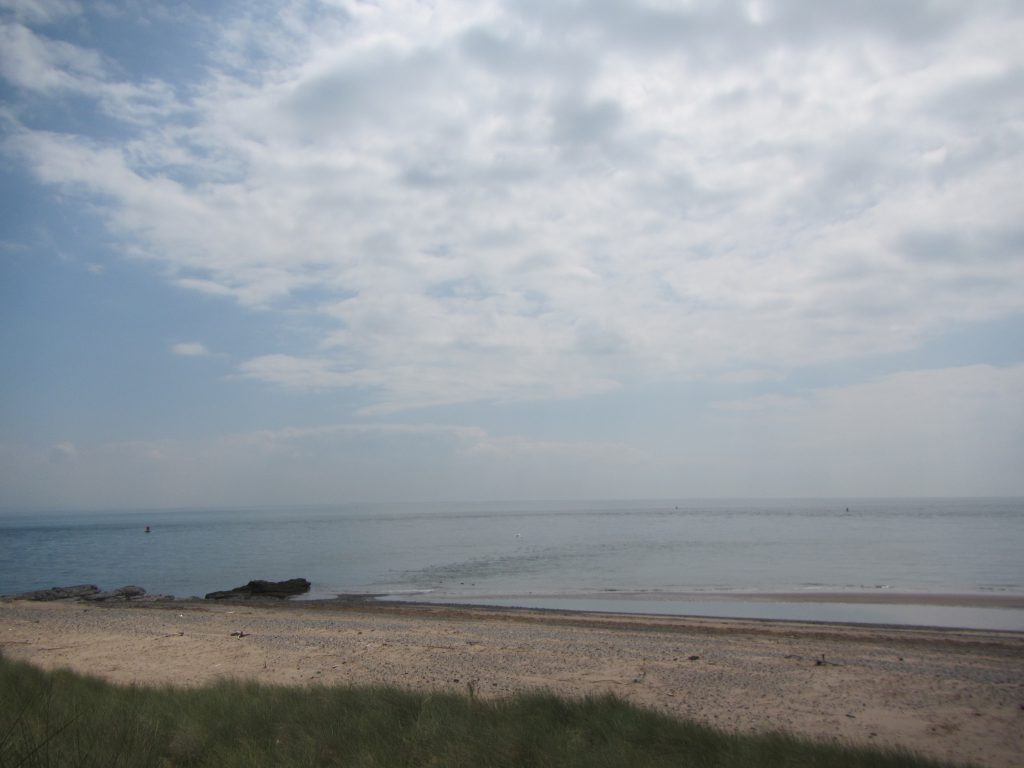
And another 20 minutes later, the formerly submerged wave breaker is revealed!
I find it always so cool when you see a wave field and just from what that wave field looks like, you can deduce what the ground underneath has to be like! In this case from seeing the hydraulic jump, you know that the wave breaker has to continue on offshore.
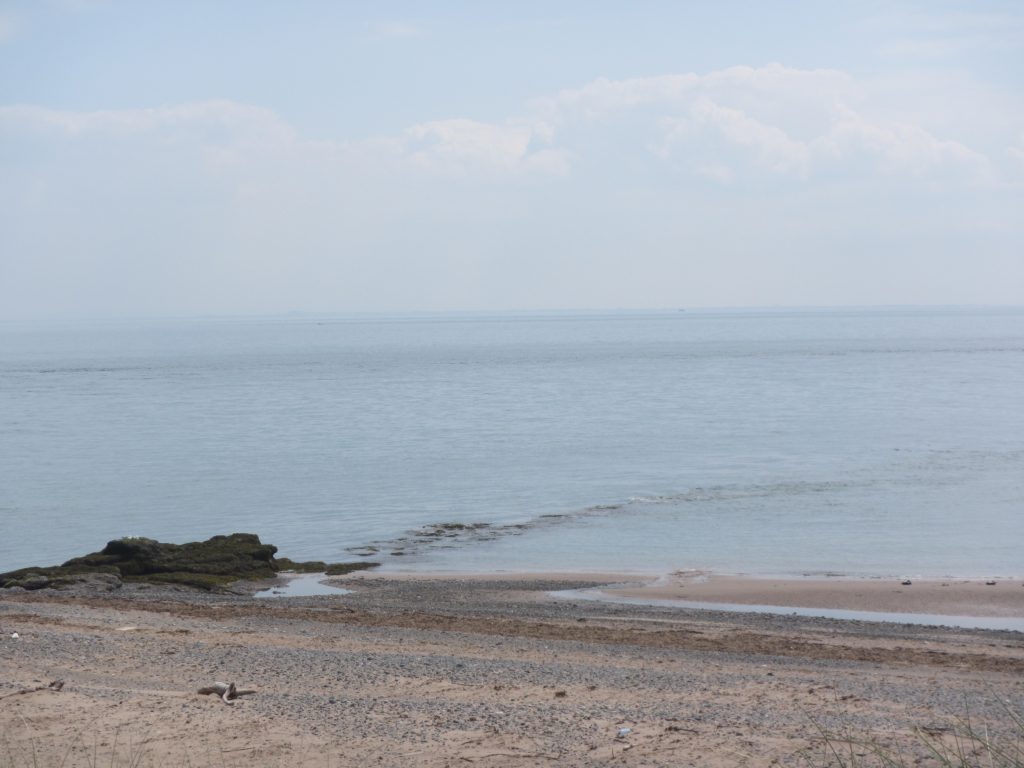
Wanna see the whole thing in action? Then here is a movie for you!
And the coolest thing is that this spectacle will repeat with every outgoing tide, so pretty much twice a day! And I am fairly confident that it will also happen halfway between, again, when the tide comes in and the current goes in the opposite direction. I would love to go back and check!
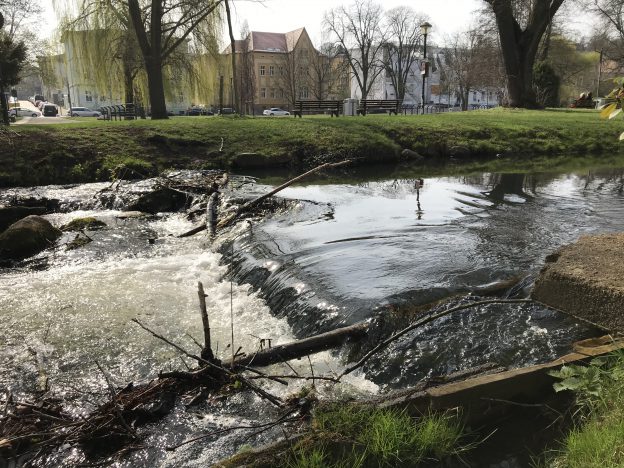
A tiny waterfall, super- and subcritical flows, submerged hydraulic jump, standing waves. What more could anyone want?
Last stop on my work trip that — apart from doing important work, obviously — brought me to Berlin for some wave watching and to Brodowin to look at beaver dams: Eberswalde.
Waiting for an appointment, I sat in the sun next to this adorable little waterfall and looked at so many nice examples of phenomena.
What I like best: The standing waves that you see in the reflection of the tree to the right. They do move a tiny little bit back and forth, but overall stay pretty much in place. In that exact spot, the current velocity is clearly as large as the waves’ phase speed, so they can’t get away in either direction.
A close second place is how smooth the turbulent current gets right before it plunges down the waterfall (see how the turbulence upstream looks like structures are more or less as long as they are wide, and then they become really long ellipses as they are accelerated towards the waterfall and the front is going faster than the back?), and the submerged hydraulic jump (and check out the video in this post for another really cool one!). And I love how the water is boiling with turbulence below the waterfall — at least in the part in the front; in the back there is a lot less flow and a lot less turbulence. Isn’t it amazing how much there is to see in such a little bit of a stream?
Btw, do you know my awesome animations to illustrate subcritical and supercritical flow regimes? Poor figurines running up and down escalators like so:
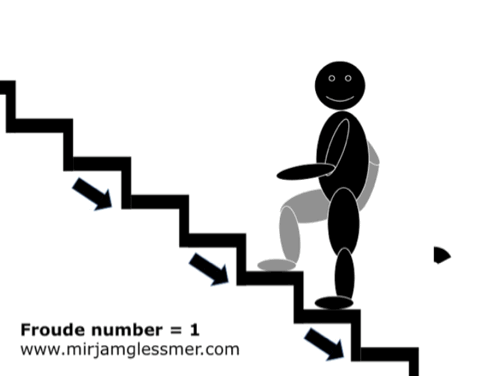
Asking students to take pictures to help them connect theory to the reality of their everyday lives
— This post was written for “Teaching in the Academy” in Israel, where it was published in Hebrew! Link here. —
Many times students fail to see the real-life relevance of what they are supposed to be learning at university. But there is an easy way to help them make the connection: Ask them to take pictures on their smartphones of everything they see outside of class, write a short sentence about what they took a picture of, and why it is interesting, and submit it on an electronic platform to share with you and their peers. And what just happened? You made students think about your topic on their own time!
Does it work?
Does it work? Yes! Obviously there might be some reluctance to overcome at first, and it is helpful to either model the behaviour you want to see yourself, or have a teaching assistant show the students what kind of pictures and texts you are looking for.
Do I have to use a specific platform?
Do I have to use a specific platform? No! I first heard about this method after Dr. Margaret Rubega introduced the #birdclass hashtag on Twitter for her ornithology class. But I have since seen it implemented in a “measuring and automation technology” class that already used a Facebook group for informal interactions (see here), and by a second class on the university’s conventional content management system. All that is required is that students can post pictures and other students can see them.
Do you have examples?
One example from my own teaching in physical oceanography: Hydraulic jumps (see figure below). The topic of hydraulic jumps is often taught theoretically only and in a way that students have a hard time realizing that they can actually observe them all the time in their real lives, for example when washing your dishes, cleaning your deck or taking a walk near a creek. But when students are asked to take pictures of hydraulic jumps, they start looking for them, and noticing them. And even if all of this only takes 30 seconds to take and post a picture (and most likely they spent more time thinking about it!), that’s 30 extra seconds a student thought about your content, that otherwise he or she would have only thought about doing their dishes or cleaning their deck or their car.
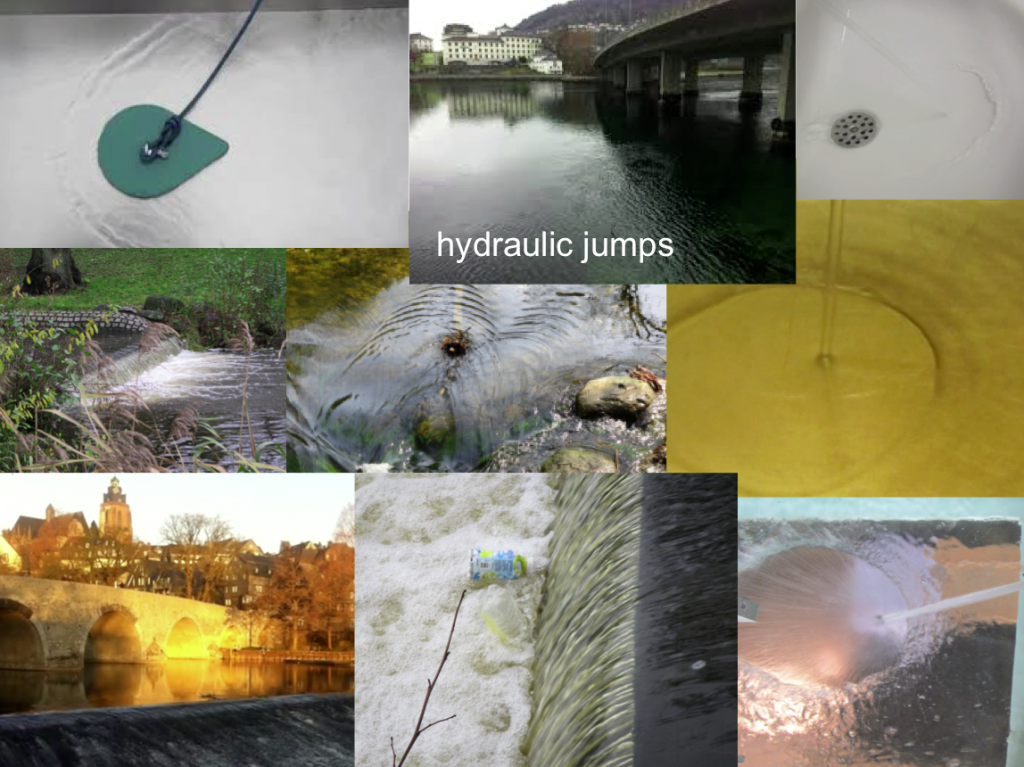
Collection of many images depicting hydraulic jumps found in all kinds of environments of daily life
And even if you do this with one single topic and not every single topic in your class, once students start looking at the world through the kind of glasses that let them spot the hydraulic jumps, they are going to start spotting theoretical oceanography topics everywhere. They will have learned to actually observe the kind of content you care about in class, but in their own world, making your class a lot more relevant to them.
An additional benefit is that you, as the instructor, can also use the pictures in class as examples that students can relate to. I would recommend picking one or two pictures occasionally, and discussing for a minute or two why they are good examples of the topic and what is interesting about them. You can do this as introduction to that day’s topic or as a random anecdote to engage students. But acknowledging the students’ pictures and expanding on their thoughts is really useful to keep them engaged in the topic and make them excited to submit more and better pictures (hence to find better examples in their lives, which means to think more about your course’s topic).
Does this work for subjects outside of STEM, too?
Does this work for subjects outside of STEM, too? Yes! In a language class, for example, you could ask people to submit pictures of something “typically English [or whatever language you are teaching]”. You can then use the pictures to talk about cultural features or prejudices. This could also be done in a social science context. In history, you might ask for examples of how a specific historical period influences life today. In the end, it is not about students finding exact equivalents – it is about them trying to relate their everyday lives to the topics taught in class and the method presented in this article is just a method to help you accomplish that.
—
P.S.: This text originally appeared on my website as a page. Due to upcoming restructuring of this website, I am reposting it as a blog post. This is the original version last modified on October 1st, 2016.
Who is faster, the currents or the waves? The Froude number
A very convenient way to describe a flow system is by looking at its Froude number. The Froude number gives the ratio between the speed a fluid is moving at, and the phase velocity of waves travelling on that fluid. And if we want to represent some real world situation at a smaller scale in a tank, we need to have the same Froude numbers in the same regions of the flow.
For a very strong example of where a Froude number helps you to describe a flow, look at the picture below: We use a hose to fill a tank. The water shoots away from the point of impact, flowing so much faster than waves can travel that the surface there is flat. This means that the Froude number, defined as flow velocity devided by phase velocity, is larger than 1 close to the point of impact.
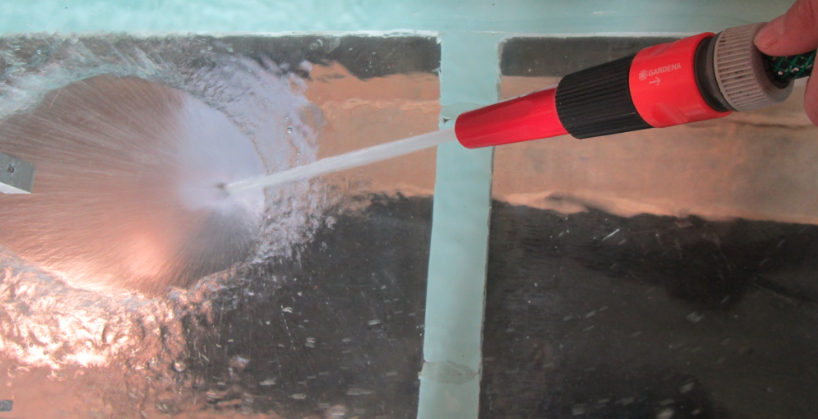
At some point away from the point of impact, you see the flow changing quite drastically: the water level is a lot higher all of a sudden, and you see waves and other disturbances on it. This is where the phase velocity of waves becomes faster than the flow velocity, so disturbances don’t just get flushed away with the flow, but can actually exist and propagate whichever way they want. That’s where the Froude number changes from larger than 1 to smaller than 1, in what is called a hydraulic jump. This line is marked in red below, where waves are trapped and you see a marked jump in surface height. Do you see how useful the Froude number is to describe the two regimes on either side of the hydraulic jump?
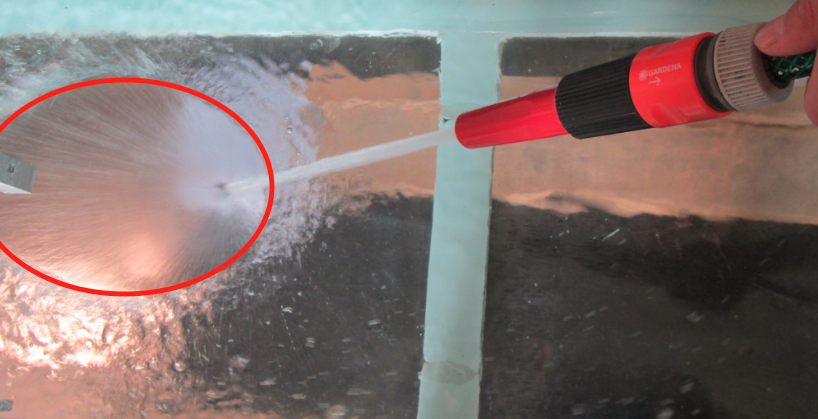
Obviously, this is a very extreme example. But you also see them out in nature everywhere. Can you spot some in the picture below?
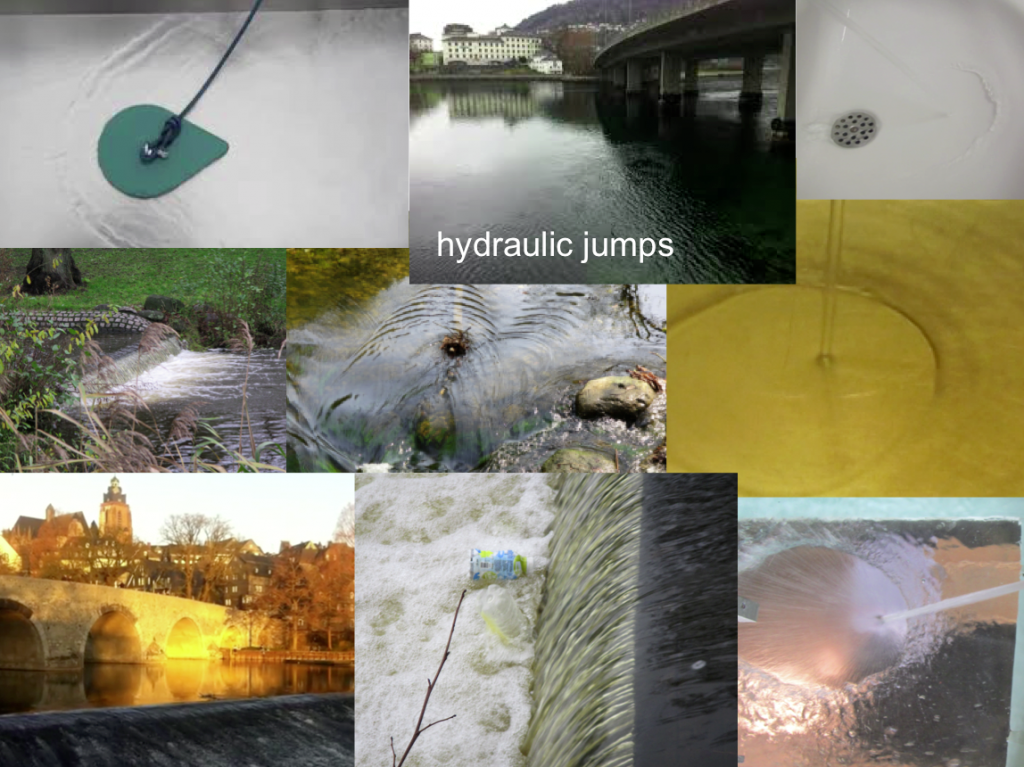
But still, all those examples are a little more drastic than what we would imagine is happening in the ocean. But there is one little detail that we didn’t talk about yet: Until now we have looked at Froude numbers and waves at the surface of whatever water we looked at. But the same thing can also happen inside the water, if there is a density stratification and we look at waves on the interface between water of different densities. Waves running on a density interface, however, move much more slowly than those on a free surface. If you are interested, you can have a look at that phenomenon here. But with waves running a lot slower, it’s easy to imagine that there are places in the ocean where the currents are actually moving faster than the waves on a density interface, isn’t it?
For an example of the explanatory power of the Froude number, you see a tank experiment we did a couple of years ago with Rolf Käse and Martin Vogt (link). There is actually a little too much going on in that tank for our purposes right now, but the ridge on the right can be interpreted as, for example, the Greenland-Scotland-Ridge, making the blue reservoir the deep waters of the Nordic Seas, and the blue water spilling over the ridge into the clear water the Denmark Strait Overflow. And in the tank you see that there is a laminar flow directly on top of the ridge and a little way down. And then, all of a sudden, the overflow plume starts mixing with the surrounding water in a turbulent flow. And the point in between those is the hydraulic jump, where the Froude number changes from below 1 to above 1.
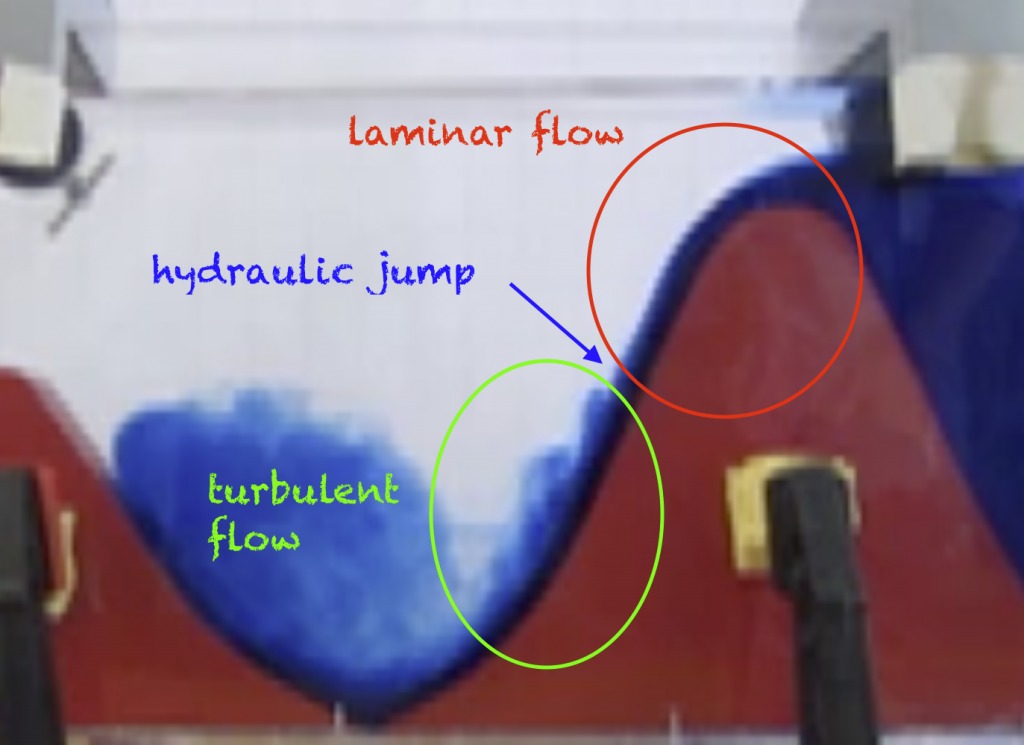
Nifty thing, this Froude number, isn’t it? And I hope you’ll start spotting hydraulic jumps every time you do the dishes or wash your hands now! :-)
Standing waves in a current
The other day I found the perfect standing waves on a current:
This egg-carton-like pattern really stays pretty constant over time and I think the changes in the wave pattern are mostly due to changes in the sand bed below!
You see the sharp edge that is currently being eroded, and sometimes you catch bits and pieces breaking off.
I think this is super fascinating. Movie below!
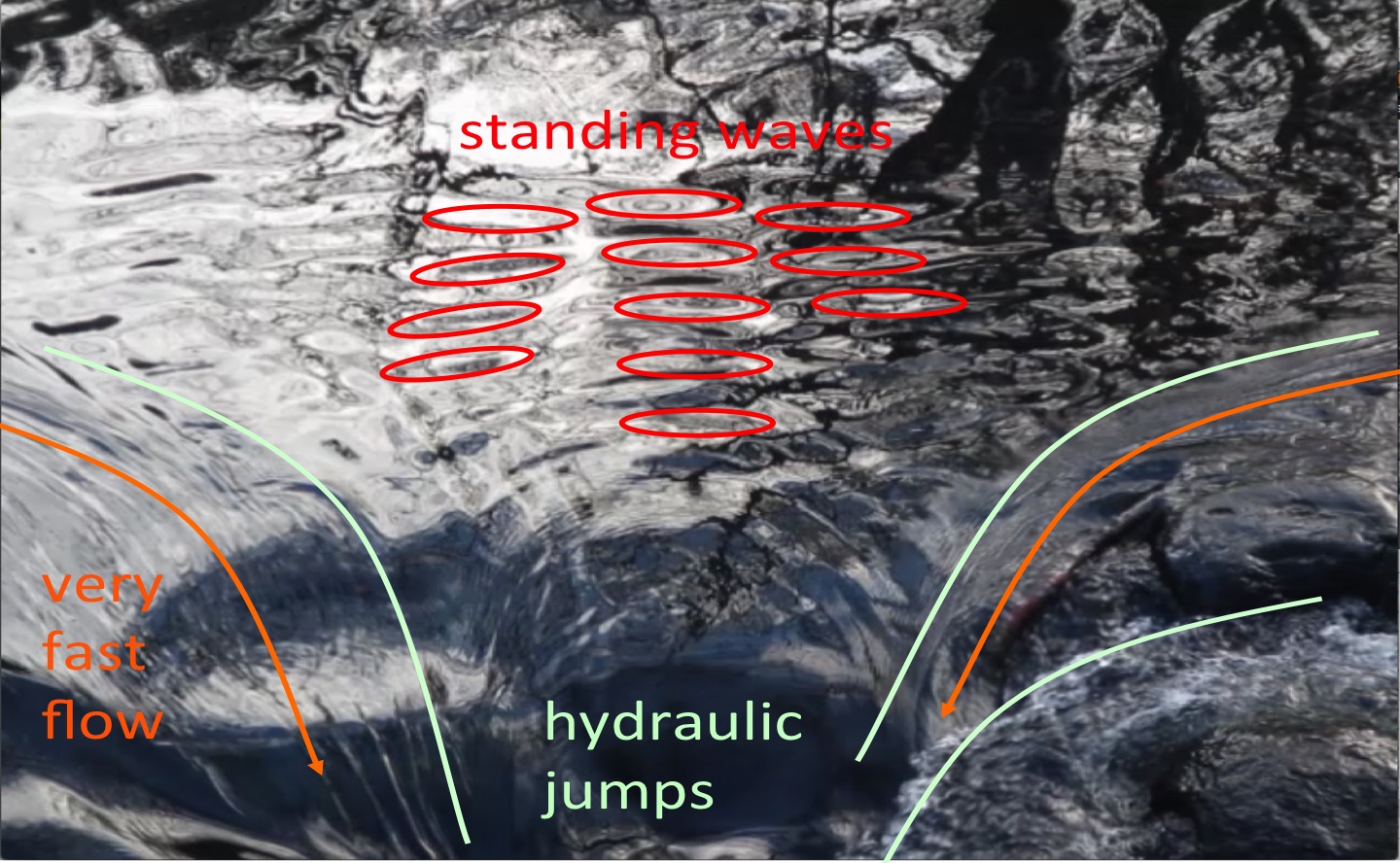
Observing hydrodynamic phenomena on a creek
Looking at a creek on a Sunday stroll, and seeing lots and lots of concepts from hydrodynamics class.
For example below, you see waves radiating from each of the ducks. And you see interference of waves from all those ducks.
What happens if the ducks bring their waves closer?
At some point, all those waves from the ducks are going to hit the weir in the picture below.
And there, they are going to somehow react to the flow field caused by the changes in topography.
And you can spot so many different phenomena: Standing waves, hydraulic jumps, and lots more!
Watch the movie below to see the whole thing even better!
Btw, you might remember this spot, I have talked about standing waves from right there before. Interestingly, the wave pattern in the other post looks really different, probably due to different water levels or changes in topography (maybe someone threw in rocks or they did some construction work on the weir?). But it is still just as fascinating as last time :-)
And for those of you who like to see a “making of”:
Using twitter as a tool to let students discover that the topics of their courses are EVERYWHERE
This is a method that I have been excited about ever since learning about #birdclass in the “Evidence-based undergraduate STEM teaching” MOOC last year: Help students discover that the content of your class is not restricted to your class, but actually occurs everywhere! All the time! In their own lives!
The idea is that students take pictures or describe their observations related to course materials in short messages, which are posted somewhere so every participant of the class can see them.
One example where I would use this: Hydraulic jumps. As I said on Tuesday, hydraulic jumps are often taught in a way that students have a hard time realizing that they can actually observe them all the time. Most students have observed the phenomenon, maybe even consciously, yet are not able to put it together with the theory they hear about during their lectures. So why not, in your class on hydrodynamics, ask students to send in pictures of all the hydraulic jumps they happen to see in their everyday life? The collection that soon builds will likely look something like the image below: Lots of sinks, some shots of people hosing their decks or cars, lots of rivers. But does it matter if students send in the 15th picture of a sink? No, because they still looked at the sink, recognized that what they saw was a hydraulic jump, and took a picture. Even if all of this only takes 30 seconds, that’s probably 30 extra seconds a student thought about your content, that otherwise he or she would have only thought about doing their dishes or cleaning their deck or their car.
And even if you do this with hydraulic jumps, and not with Taylor columns or whatever comes next in your class, once students start looking at the world through the kind of glasses that let them spot the hydraulic jumps, they are also going to look at waves on a puddle and tell you whether those are shallow water or deep water waves, and they are going to see refraction of waves around pylons. In short: They have learned to actually observe the kind of content you care about in class, but in their own world.
The “classic” method uses twitter to share pictures and observations, which apparently works very well. And of course you can either make it voluntary or compulsory to send in pictures, or give bonus points, and specify what kind and quality of text should come with the picture.
You, as the instructor, can also use the pictures in class as examples. Actually, I would recommend picking one or two occasionally and discussing for a minute or two why they are great examples and what is interesting about them. You can do this as introduction to that day’s topic or as a random anecdote to engage students. But acknowledging the students’ pictures and expanding on their thoughts is really useful to keep them engaged in the topic and make them excited to submit more and better pictures (hence to find better examples in their lives, which means to think more about your course’s topic!).
And you don’t even have to use twitter. Whatever learning management system you might be using might work, too, and there are many other platforms. I recently gave a workshop for instructors at TU Dresden and talked about how awesome it would be if they made their students take pictures of everything related to their class. They were (legitimately!) a bit reluctant at first, because you cannot actually see the topic of the course, measuring and automation technology (MAT), just the fridge or camera or whatever gadget that uses MAT. But still, going about your everyday life thinking about which of the technical instruments around you might be using MAT, and discovering that most of them do, is pretty awesome, isn’t it? And documenting those thoughts might already be a step towards thinking more about MAT. At least that is what I claimed, and it seems to have worked out pretty well.
We are about to try this for a course on ceramics (and I imagine we’ll see tons of false teeth, maybe some knees, some fuses, many sinks and coffee cups and flower pots, maybe the occasional piece of jewelry ), and I am hoping they will relate what they take pictures of to processes explained in class (like sintering, which seems to be THE process in that class ;-))
I am going to try to implement it in other courses, too. Because this is one of the most important motivators, isn’t it? The recognition that what that one person talks about in front of the class all the time is actually occurring in – and relevant to – my own life. How awesome is that? :-)
Have you tried something similar? How did it work out?
Submerged hydraulic jump – observing hydrodynamic phenomena in real life
Hydraulic jumps, especially submerged ones, are a very theoretical concept for many students, one that occurs in a lab experiment if they are lucky, but more likely only seems to exists in videos, drawings, and text books. But we can observe them all the time if we know what we are looking for! They don’t only occur in hard-to-see places like the Denmark Strait (for you oceanographers) or inside some big plant, mixing in one chemical or another (for you engineers), they are everywhere!
So. Submerged hydraulic jumps. You don’t think about them for years and years, then one day a friend (Hi, Sindre!) asks about them and the next day you come across this:
A tiny waterfall that not only shows a beautiful submerged hydraulic jump, but provides extra entertainment in the form of two empty bottles caught up in the return flow above the submerged hydraulic jump:
You should watch the video, it is really entertaining!
So what is going on here? Below a sketch: Water from the reservoir (A) flows down over a sill. It actually doesn’t flow, but it shoots (B), meaning that it flows faster than waves can propagate. Any wave in the flow that would normally propagate in all directions now cannot propagate upstream any more and is just flushed downstream. At (C), the flow has slowed down enough again that wave speed is the same as flow speed, we are at the hydraulic jump. In this case it is submerged – meaning that it occurs below the water’s surface. We can also think of non-submerged hydraulic jumps – see for example here. But what also happens with submerged hydraulic jumps is that the water jet shooting down the slope is so fast that it entrains water from outside the jet and pulls it down with it. This water has to come from somewhere, so we get a return flow (D). And this is exactly where the bottles are caught: In the flow that goes back towards the jet shooting down the slope.
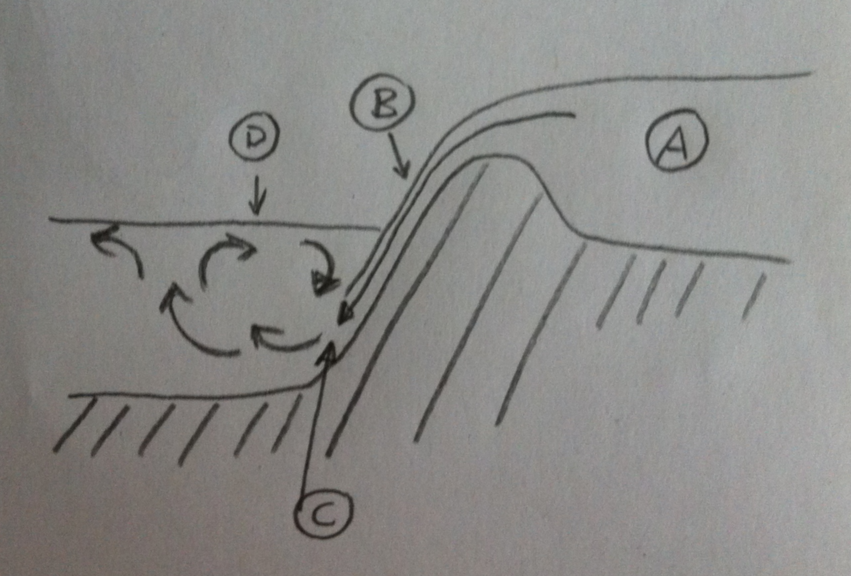
Sketch of the submerged hydraulic jump. A: reservoir. B: water shooting down the slope. C: hydraulic jump. D: turbulent return flow.
When the bottles come too close to the jet, they get pulled under water and then “jump” because they are too buoyant to actually sink. They might jump away a little from the jet, but as you see in the movie, the return flow reaches out quite a bit from where the jet enters the water, trapping the bottles.
This is actually what makes man-made waterfalls so dangerous: You saw in the movie that the return flow pattern is very similar over the whole width of the “waterfall”. So anything trapped in there will have a really hard time getting out. If either the sill or the slope were a little more irregular, it might break up the symmetry and allow things (and animals or people) to get out more easily. Of course, in this case the drop isn’t very high, but imagine a larger weir. Not fun to get caught in the return flow there!
Talking to my Norwegian friends about these things and especially using movies from my reality to illustrate concepts always makes me want to apologize for how tiny our waterfalls are, how in the middle of a city everything is, how much litter there is everywhere, how regulated even the tiniest streams around here are. But then I realize that it is actually really cool that even in the middle of the city we can spot all this. You don’t need the wide open, pristine nature to get yourself – and your students! – excited about oceanographic phenomena!
Hydraulic jumps when filling a tank
The most impressive hydraulic jump might be in the Denmark Strait, but there are others around, too! [deutscher Text unten]
When filling the big wave tank with a hose, we can see a hydraulic jump. Of course, the flow field isn’t mainly controlled by hydraulics, but still we see the Froude number changing from greater 1 to less than 1 – there is a clear boundary where the surface height jumps up and waves, that were flushed away closer to the point of impact, start propagating.
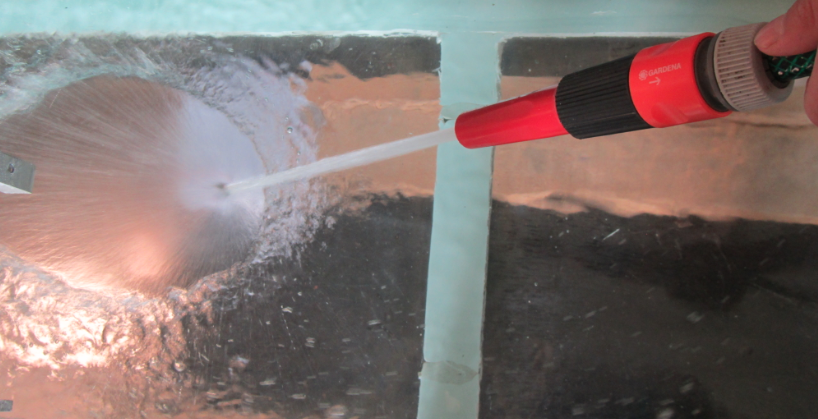
Hydraulic jump as seen from above. – Hydraulischer Sprung von oben gesehen. In diesem Bild sieht man, warum man von Strömen und Schießen spricht, oder?
Beim Befüllen des großen Tanks für die Wellenexperimente kann man schon interessante Phänomene beobachten. Obwohl die Theorie der Hydraulik die meisten Prozesse in diesem Beispiel nicht beschreibt, kann man trotzdem einen hydraulischen Sprung erkennen, an dem die Höhe der Wasseroberfläche auf einmal sprunghaft ansteigt. Am hydraulischen Sprung ist die Froude-Zahl genau 1. Auf der Seite hin zum Auftreffpunkt des Wasserstrahls schiesst das Wasser – das heisst, es fliesst schneller als die Wellengeschwindigkeit – alle Wellen werden also weggespült und können sich nicht in alle Richtungen ausbreiten. Auf der anderen Seite des Sprunges fliesst das Wasser langsamer als die Wellengeschwindigkeit, Wellen können sich also ausbreiten.
